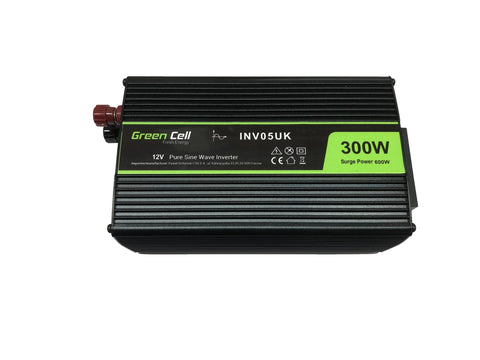Mains inverters convert 12v DC from a battery into 230v AC mains electricity. This allows small electrical devices to be powered from a car battery during a power cut. It can be used to power devices such TVs, telephones and computers. As gas/oil central heating boilers only use a small amount of electricity to ignite and pump water, it may be possible to use an inverter to keep your home warm (see note in spec).
There are four important factors to consider when purchasing an inverter, which are often conveniently overlooked by overly optimistic product ads!
Power Consumption
We only sell a 300w inverter. Whilst this may seem small, it is realistically the highest rating which can be used during a power cut from a standard car battery. The rationale can be understood by looking at the basic equation Amps = Watts/Volts.
A 300w load equates roughly to 2x TVs or a freezer. 300 watts/230volts = 1.3 Amps. So powering 300w from the mains supply pulls a total of 1.3 amps. A mains inverter has to convert that power from a 12v battery. Ignoring the power loss within the inverter itself, if you simply take 300 watts/12volts = 25 Amps. So in order to provide 300w 1.3 amps of mains power, the inverter has to take 25 amps from the battery. 25 amps is rather large! The true figure is higher, as the inverter is 85% effective.
Connecting the Inverter
We do not recommend connecting the inverter via a vehicle cigarette lighter socket, as they are generally only rated at 10-15A. The fact that the cables are only suitable for a 100w load is often in the small print, resulting in multiple product reviews online involving melted connectors. Unlike many on the market, our inverter comes with a custom made short lead with crocodile clips, for connection directly to a vehicle battery.
Battery Life
The average car has a 50Ah (amp hour) battery. This means that it can supply 50 amps for a total of one hour, or 25A to enable the inverter to power 300w for 2 hours. For all but short term use, it is therefore advisable to keep your vehicle engine running, so that the alternator charges the battery. As long as the alternator is providing more power into the battery than the inverter is taking, this method can provide electricity for a prolonged period. Check your vehicle manual for details of the maximum idling time. Ensure that your vehicle is locked if the engine is left running.
Type of Electrical Output (Sine Wave)
If you look at mains electricity using an oscilloscope, it is a pure sine wave - a smooth oscillating wave which moves up and down 50 times a second. Sensitive electronic equipment such as TVs, computers and phones are designed to be powered by electricity which is a pure sine wave.
Our inverter provides the same pure sine wave, which enables it to power sensitive equipment. We verified the output of this inverter using our own oscilloscope:

Unfortunately, most cheap inverters produce a modified sine wave, which has a staggered blocky looking appearance. They can cause irreparable damage to sensitive equipment. We used our oscilloscope to test 4 other units marketed as pure sign wave on popular shopping sites and were surprised to find that all were in fact modified sine wave. Without access to an oscilloscope, it's not possible to tell before you take the plunge and connect valuable equipment.
Specification
- 12V DC input voltage.
- 230V AC output voltage, pure sine wave, 50Hz.
- The unit can provide a continuous power rating of 300w, with a maximum peak output of 600w (1kW).
- 85% power conversion effectiveness.
- Supplied with cigarette lighting lead (only for short term 100w max use) and crocodile leads for direct connection to a battery.
- Dimensions 175x106x60mm.
- 0.8kg.
- N.B. If used to power a home central heating system, some require an earth/neutral link to be installed for the ignition system to function. Please consult a registered electrician for advice before connecting the boiler.
- The user is responsible for determining the suitability of any equipment to be powered by the inverter. Power Cut Prepper are not responsible for any damage caused by incorrect use.





